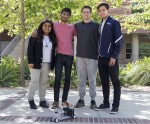A group of students hope their shoebox-sized car strapped with two Gatorade bottles inches its way to victory at a competition in two weeks.
Chem-E-Car is an organization under the American Institute of Chemical Engineers in which students build shoebox-sized cars powered and stopped by chemical reactions. This year, the students have built two new cars that will be competing in the Western Regional Student Conference in Irvine from April 27 to April 28.
Mitchell Rockey, a fourth-year chemical engineering student leading one of the teams competing in the conference, said he likes competing at western regionals and nationals because he finds it fun to see something he has spent all year working on move and compete.
“I’ve noticed I have a lot more fun working with a hands-on project than working with a theoretical project,” he said.
In the competition, the car must travel a specified distance between 15 to 30 meters within two minutes while carrying zero to 500 milliliters of water, Rockey said. If the car travels more than 30 meters, it will be disqualified.
In order to get the car to stop within the specified range, the teams must create precise stopping mechanisms using chemical reactions. The car that reaches the range and gets closest to the designated time wins the competition. The top two teams at the regional conference then go to the national conference.
Jordy Supandi, a second-year mechanical engineering student who is on Rockey’s team, said it would be too complicated to just use one chemical reaction to stop and start the car, so the car uses two separate mechanisms, one for powering the car and one for stopping it. That way, the team can be sure the car moves at constant velocity and stops in the designated distance, he said.
Zubin Mishra, a third-year chemical engineering student who is also leading a team in the conference, said they are using a hydrogen fuel cell to power the car and a sodium thiosulfate clock to stop the car. Rockey’s car will be powered by a magnesium-air battery and will also use a sodium thiosulfate clock to stop the car.
Mishra said there are many similarities among the cars in the competition – many use hydrogen fuel cells to power the car. However, he said some teams’ cars have unique powering mechanisms, such as using an enzyme in spinach that releases gas to power the car.
Rockey said if two teams have the same stopping and starting mechanisms, the cars’ performances depend on their design and how precise the students are in measuring the chemicals.
Chem-E-Car was able to borrow a 3-D printer from the engineering department this year to create the body of their car, Mishra said. Last year, they had to laser-cut the body of the car, which Supandi said was more difficult.
“I like working with computer-aided design software and using 3-D printers,” Supandi said. “It was exciting to see how a machine took something from your computer and brought it to life.”
Richa Ghosh, a second-year chemical engineering student, said Chem-E-Car has taught members how to work well as a team and overcome challenges.
“The first stopping mechanisms didn’t work, (but) we learned how to push through difficulties, and got really close,” she said. “It was a good team bonding experience.”
